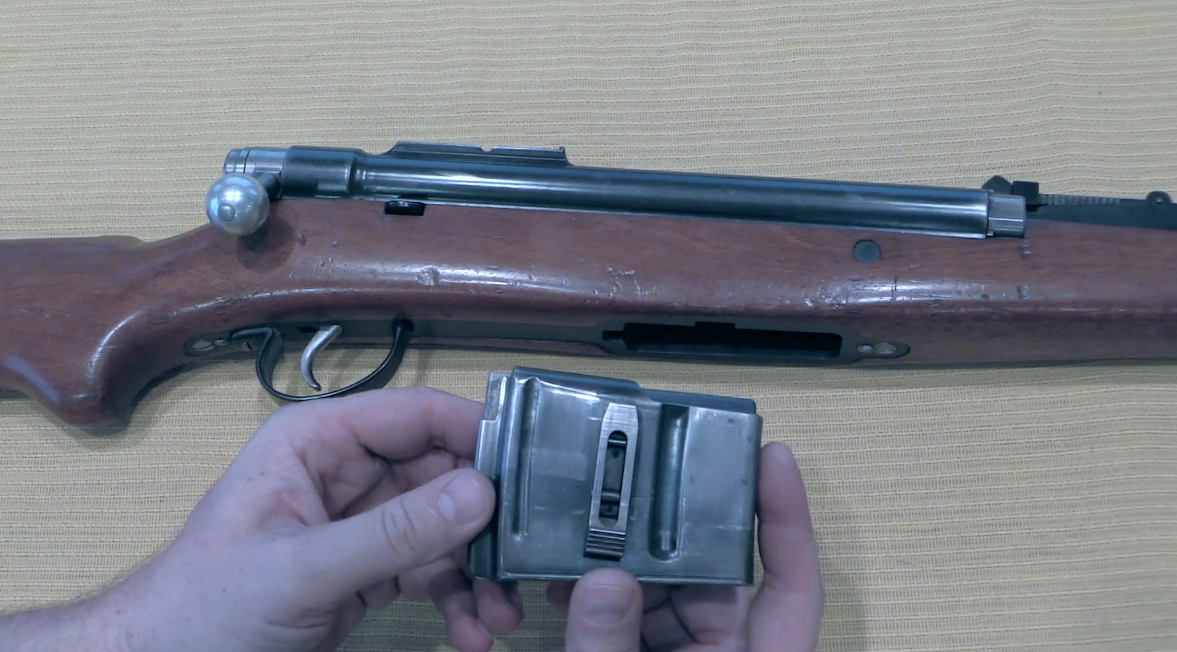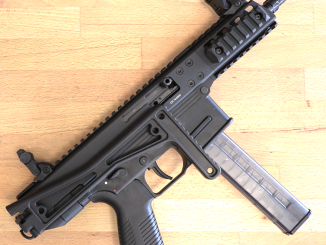SIG began making SMGs in the 1920s with a licensed copy of the Bergmann. In 1927 the license expired, and they began working on their own designs, the first of which was introduced as the Modell 1930. This was replaced in 1933 by a design from SIG engineer Gotthard End, using Pal Kiraly’s lever-delayed blowback mechanism. This was the MKMO or MKPO, with the military (M) long barrel or police (P) short barrel. It was chambered for 9x25mm Mauser, and was made to beautiful, exacting standards as one would expect of 1930s SIG. However, this made it expensive, and the 9x25mm cartridge never really caught on. In 1937 the design was simplified to the MKMS or MKPS, now using a simple blowback mechanism and offered in 7.63mm Mauser, 7.65mm Parabellum, and 9x19mm Parabellum. The example we have today is a 9x19mm MKPS.
Even in this less expensive form, the guns were really not successful. Only 1,228 were made of all models combined, with the most notable buyers being the Vatican Swiss Guard and Finland (who bought 282 in March-June 1940). Mechanically, they have several excellent features, including folding magazine wells for storage and several integral mechanical safeties. The trigger will not function if the receiver endcap is not fully screwed on, and it cannot be unscrewed unless the manual safety is engaged. They do not have a semiauto function, however.




O and S denotes the direction of the case ejection: Obenauswerfer (gun ejecting brass vertically, through an ejection opening on top) and Seitenauswerfer (gun ejecting brass horizontal-ish, through an ejection opening in the side of the receiver).
Why can’t I view the video on the SIGSMG?
Link to video appears broken
Highlight, copy, paste into another browser window.
This happens ALOT. It’s weird….some of the videos are fine, others don’t exist?!
I did not realize that these were competitors with the Furrer… How on God’s green earth did the Furrer manage to win that competition? That fact really argues for either a very strong sense of delusion in the Swiss military, or Furrer having blackmail material on the commission making the decision, because it sure as hell wasn’t made on any basis of rationality.
Furrer was an army officer(!) and in charge of the state owned Waffenfabrik Bern. A statement by a military person with decades of military service in ordnance matters counted much more in the military than that of “outsiders” like SIG engineers, civilians at that.
As in other armies at the time, military officers laid down the specifications as they saw fit and finally decided the result. No discussion. Lawsuits were unthinkable, because the plaintiff would never again have gotten any military contract.
On the other hand, military had an active interest to keep manufacturers of military items in business. That led to issuing other contracts to the losing competitor.
Kirk:
Probably in the same way we ended up with 7.62mm NATO.
In other words, fundamental irrationality…
I’d never really paid any attention to the timeline–I knew of these, but I thought they were a “Let’s try getting this right…” sort of affair after they adopted the Furrer.
Furrer must have had an amazingly persuasive personality, is all I can say.
“(…)How on God’s green earth did the Furrer manage to win that competition?(…)”
https://modernfirearms.net/en/submachine-guns/switzerland-submachine-guns/wf-lmg-pist-4144-eng/ claims that It was produced for army trials andhastily adopted in 1941 over four other contestants, with the main reasons for adoption being, most probably, the similarity of the design to the already adopted and proven 7.5mm Lmg 25 light machine gun of the same designer and the importance and influence of the designer Col. Furrer, who at the time was superintendent of the W+F factory.
That is suggest selling point was that it was akin to already used weapon (light machine gun)
https://wwiiafterwwii.wordpress.com/2016/07/31/mp-4144-submachine-gun-post-wwii-use/ suggest that he… did not provide honest data for said weapon
The W+F MP 41/44 was 2’7″ long. The weight is an item of perspective; to win the contract Furrer gave an “issue weight” of 8 ¾ lbs; this was the bakelite version with no magazine inserted; this was barely lighter than the SIG gun’s weight including it’s magazine. W+F’s all-wood version with magazine weighed 11 ½ lbs and with the bayonet fitted, it topped 12 lbs; about as heavy as an infantry rifle.
And apparently was able to rig reliability tests as default 9×19 mm often do not have enough oomph to cycle it properly, therefore
The Swiss army tried to rectify some issues with new operational guidelines; sometimes with unintentionally humorous results. For example, it suggested making adjustments to the spring if the gun was repeatedly fired on an incline, such as from a mountain into a valley. Obviously there was no way soldiers could realistically do this in the event of a real war.
https://modernfirearms.net/en/submachine-guns/switzerland-submachine-guns/sig-mp-41-2/ sums that well The iconic Swiss company submitted about 50 units for testing. However, instead of conducting fair tests, for nebulous reasons, the Swiss Army adopted a much more complicated and expensive weapon. This was the W+F Lmg.Pist 41…
This reply also to Kirk, John K & J. Peelen above: I would recommend you go to Bloke on the Range and listen to the comments on Furrer over there, some of which were made in the two joint interviews with Mr. M. on this channel. The Bloke asserts, through gossip accumulated in Switzerland, that “Furrer had a seat at the table,” Swiss slang for “friends in high places.” Furrer amazingly gets credit for SIMPLIFYING the 1892 revolver, shaving quite a few francs off the purchase price at cost of a slightly worse double-action trigger pull.
Kirk
On a similar line of thought to Furrer, as an ensconsed bureaucrat who knows how to build an empire and feather nests
And also how to hold grudges and carry out merciless Vendettas.
Have you read (or listened to) Robert F Kennedy Jr’s “the real Anthony eff ouch! eeeeeeeeee”?
I had a good link for a free download of the audio, that seems to have died
I think it’s free on audible
Did you or will bid on this beautiful piece?
Beautiful, functional, and probably priced in thousands of Swiss Francs. Too bad I don’t have a convenient crate of gold bars to trade for this gun…
Now I am wondering which caliber the Swiss Guard chose?
With its Papal connection would this be an appropriate weapon for the Gun Jesus?
A beautifully thought out and beautifully finished gun 🙂
The tension spring on the trigger is totally incongruous. Even Granny Murgatroyd’s clothes pegs have nicer springs.
The other place I’m aware of a tension spring in a trigger is a Remington
turdnylon 66.‘nough said
At least the Swiss had the good sense to adopt the Suomi kp/31, albeit manufactured by Hispano-Suiza MP43/44.